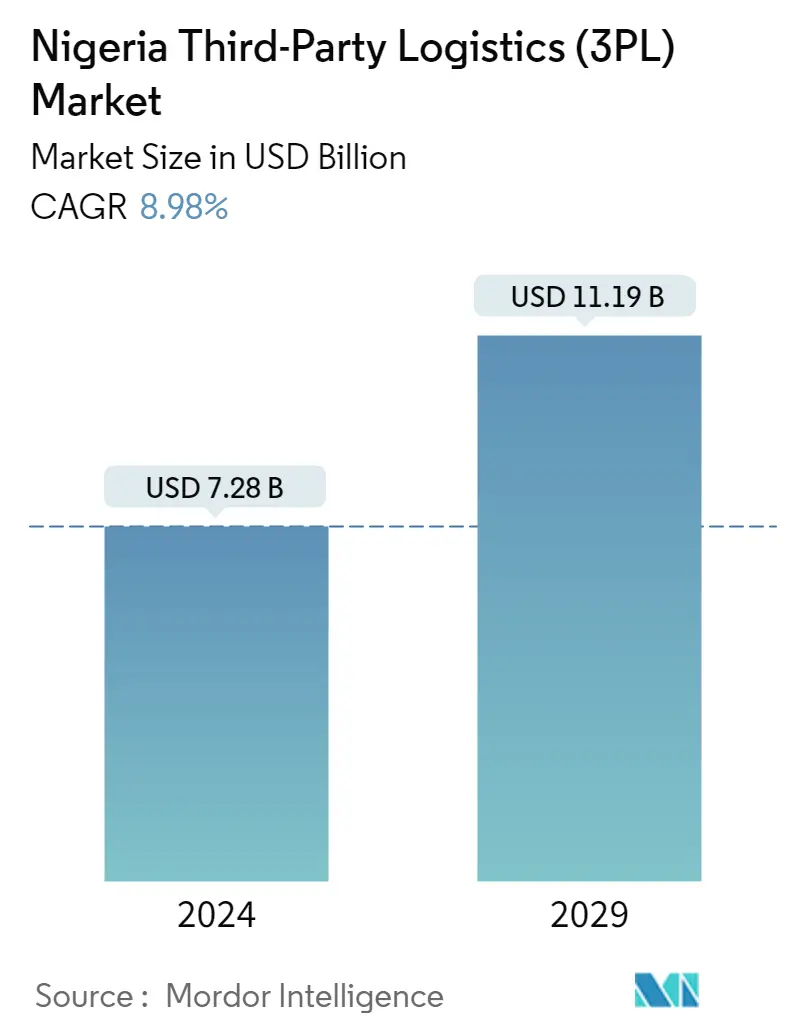Market Size of Nigeria Third-Party Logistics (3PL) Industry

| Study Period | 2020 - 2029 |
| Base Year For Estimation | 2023 |
| Market Size (2024) | USD 7.28 Billion |
| Market Size (2029) | USD 11.19 Billion |
| CAGR (2024 - 2029) | 8.98 % |
| Market Concentration | Low |
Major Players
*Disclaimer: Major Players sorted in no particular order |
Nigeria Third-Party Logistics (3PL) Market Analysis
The Nigeria Third-Party Logistics Market size is estimated at USD 7.28 billion in 2024, and is expected to reach USD 11.19 billion by 2029, growing at a CAGR of 8.98% during the forecast period (2024-2029).
- COVID-19 severely impacted the Nigeria 3PL Market as the supply chains were disrupted worldwide. The growth of the Nigeria 3PL The growth of intra-continental trade through the African Continental Free Trade Agreement (AfCFTA) is what fuels the growth of the Nigerian 3PL market. Moreover, the growth in the manufacturing sector and the change in consumption patterns contribute to market growth, which has increased demand for logistics services.
- The main economic constraints are infrastructure gaps and disjointed supply chains among the nations. African countries have to strategically and heavily invest in their infrastructure.
- Along with the infra development, the synchronization of regulations related to different sectors (such as pharmaceutical products) and sub-regional blocks is necessary to support trade and a favorable business climate.
- Nigeria's logistics sector is expanding due to infrastructure development in railways and airways, improved ties with other countries, growth in the manufacturing and export sectors, and e-commerce.
- According to a survey conducted by the Lagos Chamber of Commerce and Industry, the Nigerian economy lost an estimated annual revenue of 3.46 trillion naira (USD 8.4 billion) due to poor infrastructure, poor implementation, and corruption at ports, of which 2.5 trillion naira (USD 6 billion) are corporate earnings losses across the economy.
- According to the report, profit margins of corporate entities that use some of the country's key infrastructure, such as the Apapa port, have gradually shrunk as logistics costs have risen significantly.
- In the first quarter of 2021, Apapa port handled the majority of export transactions, with goods worth 2.58 trillion nairas (USD 6 billion), accounting for 88.91% of total exports. Port Harcourt came in second with 167.29 billion nairas (USD 406 million), or 5.75%. Revenue at Mohammed Murtala International Airport increased by 2.5% to 75.4 billion naira (USD 183 million).
- In terms of imports, Apapa Port had the most transactions, valued at 2.92 trillion nairas (USD 7.1 billion), accounting for 42.73% of total imports. Tin Can Island came in second with 1.2 trillion nairas (USD 2.9 billion) or 17.95%, Port Harcourt came in third with 691.7 billion nairas (USD 1.6 billion) or 10.10%, and Muhammed Murtala International Airport came in third with 625.7 billion nairas (USD 1.52 billion) or 9.13%.
Nigeria Third-Party Logistics (3PL) Industry Segmentation
A 3PL (third-party logistics) provider provides outsourced logistics services, which include the management of one or more aspects of procurement and fulfillment activities. This report includes a complete background analysis of the Nigeria Third-Party Logistics (3PL) Market, including the assessment of the economy and contribution of sectors in the economy, market overview, market size estimation for key segments, and emerging trends in the market segments, market dynamics, and geographical trends, and COVID-19 impact.
The Nigeria third-party logistics (3PL) market is segmented by type (domestic transportation management, international transportation management, and value-added warehousing and distribution) and by end-users (manufacturing and automotive, oil and gas, and chemicals, distributive trade(wholesale and retail trade including e-commerce), pharma and healthcare, construction, and other end users). The report offers market size and forecasts for the Nigeria Third-Party Logistics (3PL) Market in value (USD Billion) for all the above segments.
| By Service | |
| Domestic Transportation Management | |
| International Transportation Management | |
| Value-added Warehousing and Distribution |
| By End-User | |
| Manufacturing & Automotive | |
| Oil & Gas and Chemicals | |
| Distributive Trade (Wholesale and Retail trade including e-commerce) | |
| Pharma & Healthcare | |
| Construction | |
| Other End Users |
Nigeria Third-Party Logistics (3PL) Market Size Summary
The Third-Party Logistics (3PL) market in Nigeria is poised for significant growth, driven by the expansion of intra-continental trade through the African Continental Free Trade Agreement (AfCFTA) and advancements in the manufacturing sector. The market is experiencing increased demand for logistics services due to changing consumption patterns and infrastructure development in railways and airways. However, challenges such as infrastructure gaps and disjointed supply chains remain, necessitating strategic investments and regulatory synchronization to enhance trade and create a favorable business environment. The logistics sector's growth is further supported by improved international relations, e-commerce expansion, and initiatives like the "Make in Nigeria for Export" project, which aims to boost manufacturing and export capabilities.
The Nigerian 3PL market is characterized by a fragmented landscape with numerous local and international players, including major companies like FedEx, UPS, Maersk, and DHL International GmbH. Despite the challenges posed by COVID-19 and infrastructure issues, the market is expected to grow rapidly, attracting global investments. The AfCFTA is anticipated to revolutionize trade across Africa, enhancing production capabilities and economic diversification. This trade agreement, if fully implemented, could significantly boost regional income and create millions of jobs, contributing to poverty alleviation. The Nigerian logistics market's growth trajectory is supported by ongoing infrastructure projects, regulatory improvements, and strategic initiatives aimed at enhancing the country's manufacturing and export potential.
Nigeria Third-Party Logistics (3PL) Market Size - Table of Contents
-
1. MARKET INSIGHTS AND DYNAMICS
-
1.1 Current Market Scenario
-
1.2 Market Overview
-
1.3 Market Dynamics
-
1.3.1 Drivers
-
1.3.2 Restraints
-
1.3.3 Opportunities
-
-
1.4 Value Chain / Supply Chain Analysis
-
1.5 Porter's Five Forces Analysis
-
1.5.1 Threat of New Entrants
-
1.5.2 Bargaining Power of Buyers/Consumers
-
1.5.3 Bargaining Power of Suppliers
-
1.5.4 Threat of Substitute Products
-
1.5.5 Intensity of Competitive Rivalry
-
-
1.6 Value Chain / Supply Chain Analysis
-
1.7 Industry Policies and Regulations
-
1.8 General Trends in Warehousing, CEP, Last Mile Delivery, Cold Chain Logistics Etc.
-
1.9 Insights on E-commerce Business
-
1.10 Technological Developments in the Logistics Sector
-
1.11 Impact of Covid-19 on the Market
-
-
2. MARKET SEGMENTATION
-
2.1 By Service
-
2.1.1 Domestic Transportation Management
-
2.1.2 International Transportation Management
-
2.1.3 Value-added Warehousing and Distribution
-
-
2.2 By End-User
-
2.2.1 Manufacturing & Automotive
-
2.2.2 Oil & Gas and Chemicals
-
2.2.3 Distributive Trade (Wholesale and Retail trade including e-commerce)
-
2.2.4 Pharma & Healthcare
-
2.2.5 Construction
-
2.2.6 Other End Users
-
-
Nigeria Third-Party Logistics (3PL) Market Size FAQs
How big is the Nigeria Third-Party Logistics (3PL) Market?
The Nigeria Third-Party Logistics (3PL) Market size is expected to reach USD 7.28 billion in 2024 and grow at a CAGR of 8.98% to reach USD 11.19 billion by 2029.
What is the current Nigeria Third-Party Logistics (3PL) Market size?
In 2024, the Nigeria Third-Party Logistics (3PL) Market size is expected to reach USD 7.28 billion.

